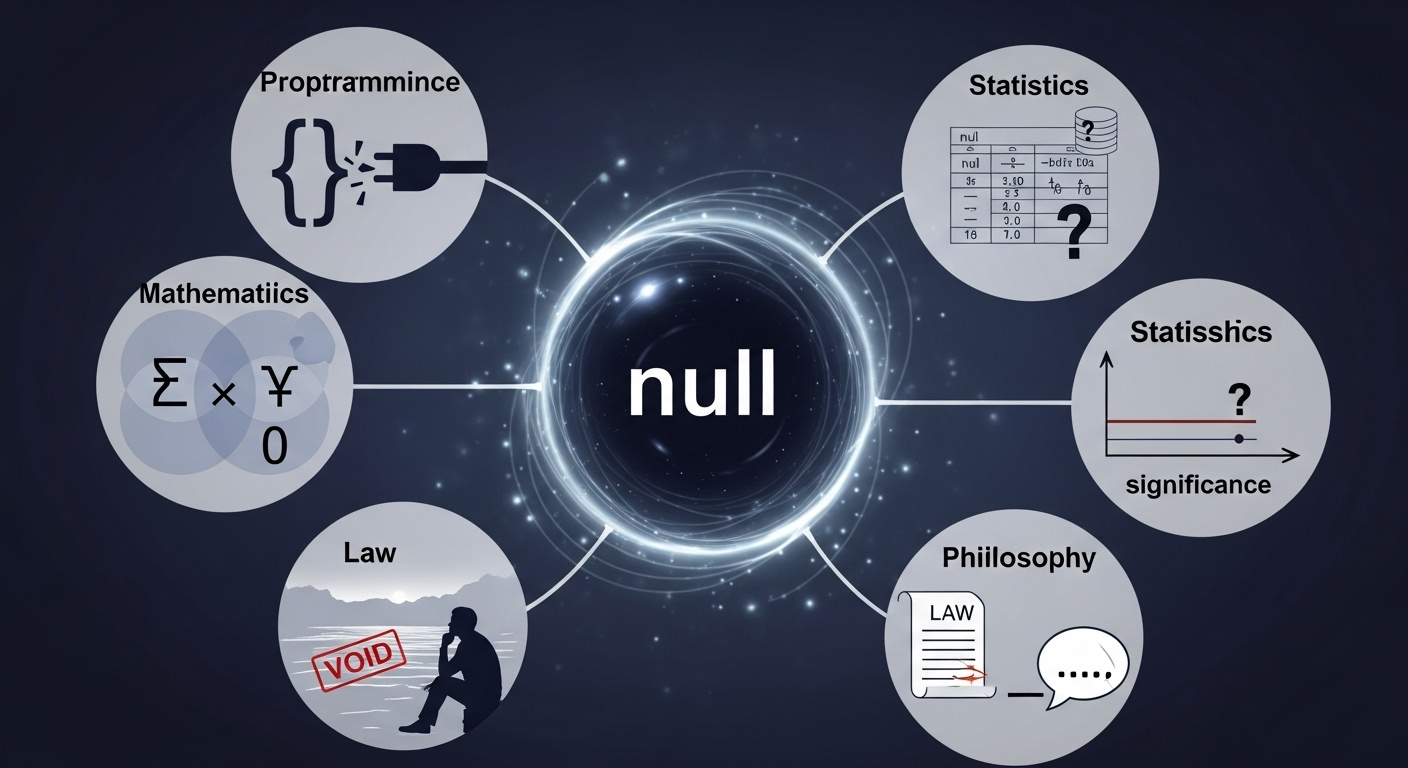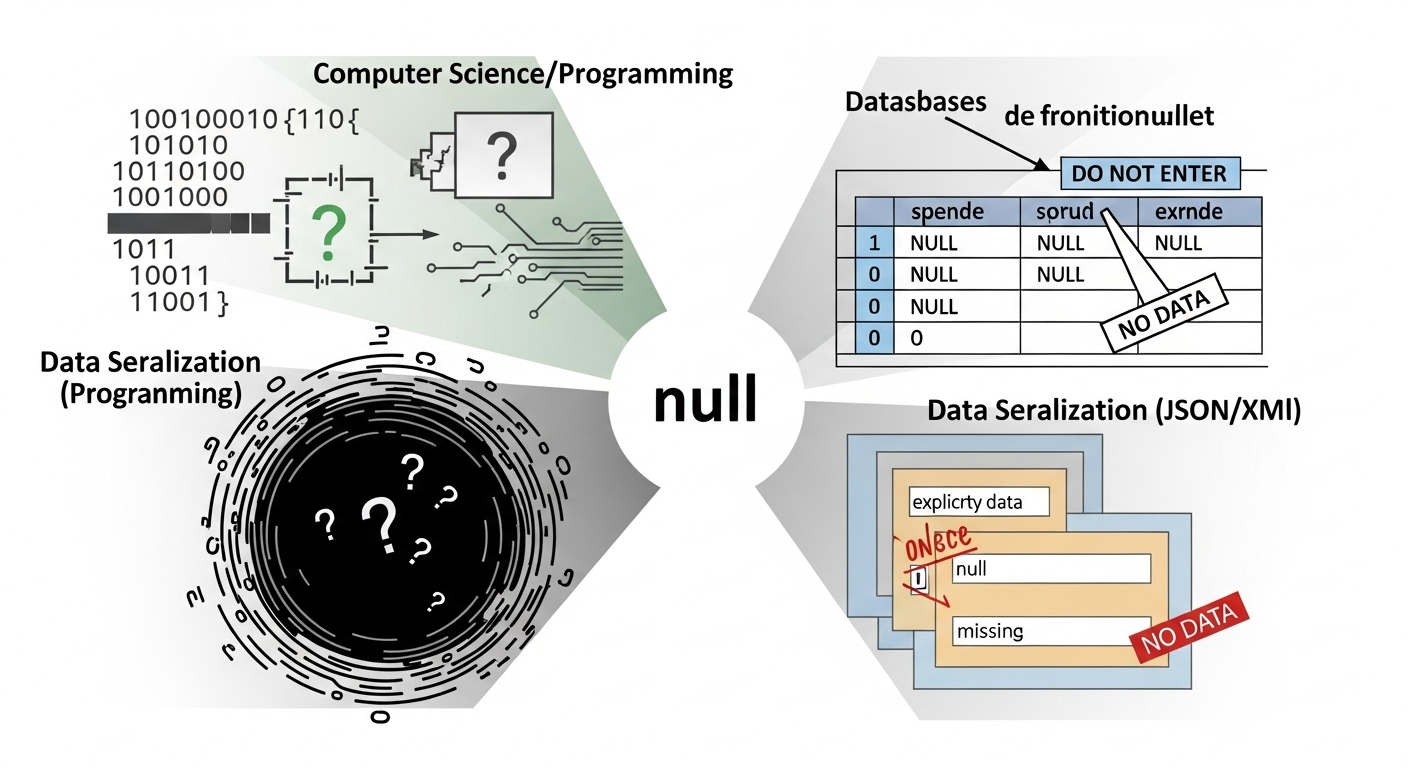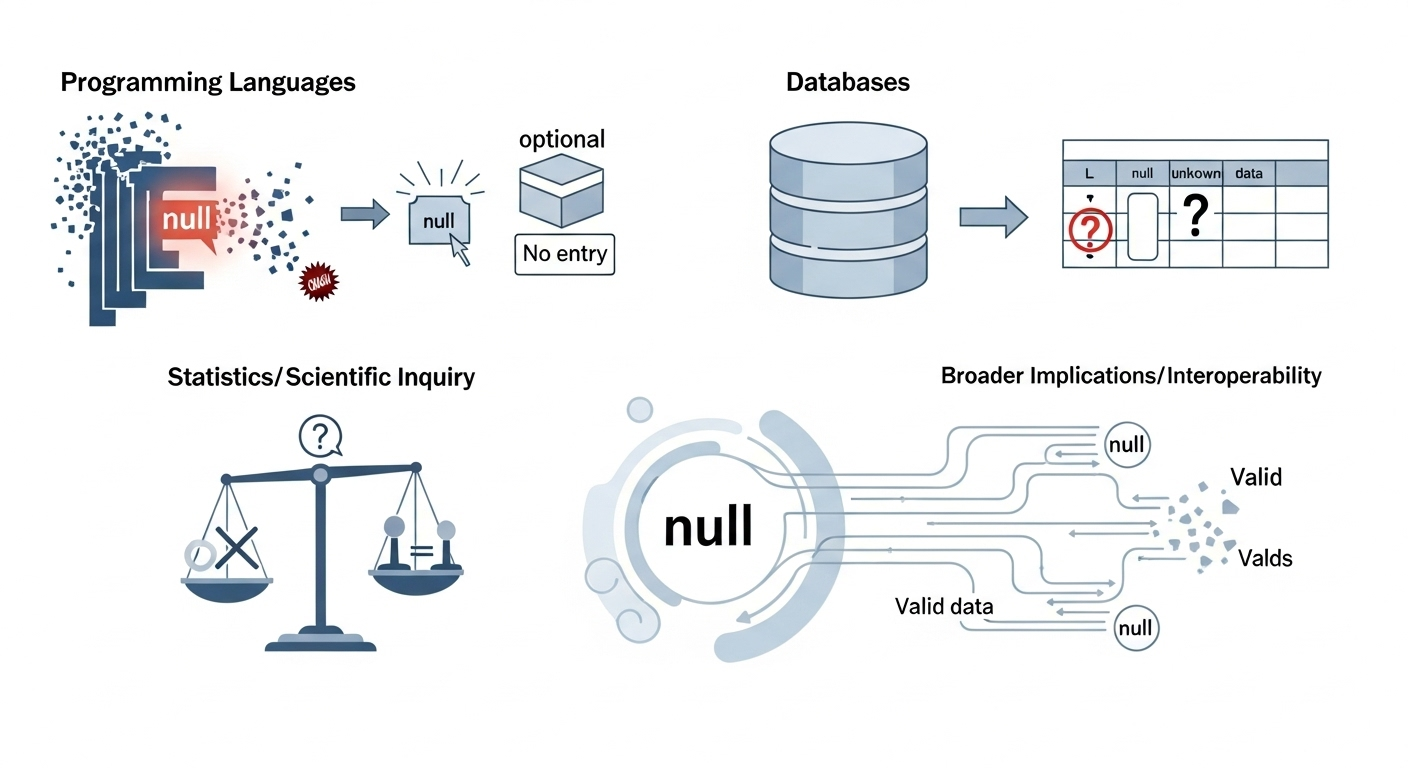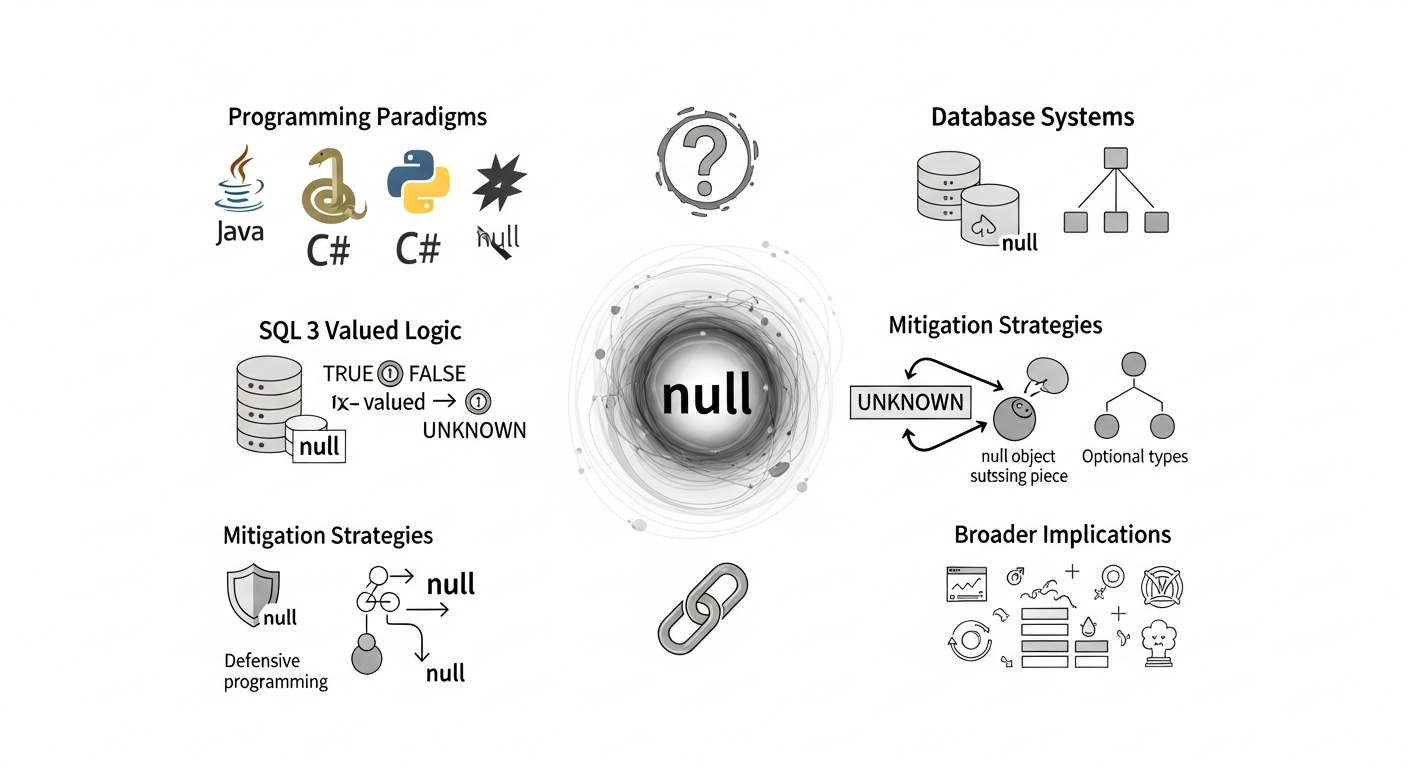Understanding 'Null': Exploring Its Pervasive Role Across Technology, Science, and Abstract Thought
The term 'null' frequently appears in everyday discourse, often implying an absence or lack. However, its true significance transcends simple negation, encompassing a complex set of meanings and applications across numerous disciplines, from software engineering to philosophical inquiry. This guide aims to dissect the multifaceted nature of 'null', exploring its definitions, implications, and the challenges it presents in various contexts.

Deciphering the Core Concept of 'Null'
At its most fundamental, 'null' denotes the absence of a value, meaning, or entity. It is not synonymous with zero, an empty string, or false; rather, it signifies a state of non-existence or an undefined condition. This distinction is crucial, as misinterpreting 'null' can lead to profound logical errors, system failures, or miscommunications. The concept of 'null' serves as a critical placeholder for what is not yet present, or what simply does not exist in a given context.
'Null' in the Digital Landscape: Computer Science and Engineering
The domain where 'null' perhaps holds its most prominent and impactful role is computer science. Here, 'null' is a foundational concept with significant implications for program design, data management, and system reliability.
Programming Languages: The Absence of a Reference
In many programming languages, 'null' (or its equivalents like None in Python, nil in Ruby/Swift/Go, or nullptr in C++) signifies a pointer or reference that does not point to any valid object or memory address. This distinction from an empty string (which is a valid string of zero length) or zero (which is a valid numerical value) is paramount.
- Null Pointers/References: A null pointer essentially indicates that a variable, intended to hold an address of a memory location, currently holds no such address. Attempting to dereference a null pointer—that is, trying to access the data it supposedly points to—is a common programming error that frequently results in application crashes, known as a 'null pointer exception' or 'segmentation fault'.
- Representing State: Programmers often utilize 'null' to represent a specific state, such as an optional value that hasn't been provided, a resource that hasn't been initialized, or an error condition where a requested object could not be found. Managing these 'null' states explicitly is critical for robust software design.
- Language-Specific Handling: While the concept is similar, how 'null' is handled varies. Some languages, like C#, have nullable types, allowing value types (e.g., integers) to explicitly be assigned 'null'. Others, like Rust, eschew 'null' pointers entirely in favor of 'Option' types, which force developers to explicitly handle the presence or absence of a value, thereby reducing a significant class of runtime errors. This architectural choice reflects a deeper understanding of the inherent dangers associated with unmanaged 'null' references.
Databases: Undefined or Unknown Data
In relational databases, particularly those using SQL, NULL represents a value that is unknown or missing. It is a distinct marker and not equivalent to an empty string, a zero, or a boolean false. This distinction has profound implications for data integrity, query results, and data analysis.
- SQL
NULLSemantics: When comparing values,NULLbehaves differently. A comparison likeNULL = NULLdoes not evaluate to true; instead, it evaluates toUNKNOWN. This is because two unknown values cannot be definitively declared equal. Special operators likeIS NULLorIS NOT NULLare required to check for the presence or absence of a value. - Impact on Queries: The presence of
NULLvalues can significantly alter the outcome of database queries. Aggregate functions (likeSUM,AVG,COUNT) typically ignoreNULLvalues by default, which can lead to different results than if zero or empty strings were used. Joins involving columns withNULLcan also behave unexpectedly if not carefully managed. - Constraints and Data Integrity: Database schemas often include
NOT NULLconstraints to prevent columns from holdingNULLvalues, ensuring that specific data points are always present. This is a vital tool for maintaining data integrity and business rules. However, allowingNULLcan also be a deliberate design choice, reflecting that certain attributes might genuinely be optional or currently unknown.
Data Serialization and Protocols: Representing Absence
In formats like JSON (JavaScript Object Notation) and XML (Extensible Markup Language), 'null' is used to explicitly represent the absence of a value for a given field. For instance, in JSON, a field might be declared as "someField": null to indicate that it exists but currently holds no value, distinguishing it from the field simply being omitted (which implies it might not exist at all within the current data structure). This explicit representation of 'null' is crucial for clear data exchange between different systems and ensuring consistent interpretation of optional or missing data points.
'Null' in the Abstract Realms: Mathematics and Statistics
While computer science deals with concrete representations, 'null' also finds conceptual footing in more abstract fields, albeit with distinct definitions.
Mathematics: Zero vs. the Null Set
In mathematics, the concept closest to 'null' is often 'zero' or the 'empty set'. However, these are not direct equivalents of the computer science 'null'.
- Zero (0): Zero is a number, a quantity representing nothing. It is a valid numerical value used in arithmetic.
0 + 5 = 5,0 * 5 = 0. Zero is an active participant in mathematical operations. - The Empty Set (∅ or {}): The empty set is a set containing no elements. It is a well-defined mathematical object with specific properties in set theory. It is a subset of every set, and its cardinality (number of elements) is zero. The empty set is not 'nothingness' in an absolute sense; it is a specific kind of set, characterized by the absence of members.
- Null Space: In linear algebra, the 'null space' (or kernel) of a linear transformation refers to the set of all vectors that are mapped to the zero vector by that transformation. This concept is fundamental in understanding the properties of linear mappings and solving systems of linear equations. The vectors within the null space are specific, non-null entities that, when acted upon, result in a zero outcome.
Statistics: The Null Hypothesis
In inferential statistics, the 'null hypothesis' (H₀) is a foundational concept. It typically states that there is no significant relationship between two measured phenomena or no significant difference between groups. For example, a null hypothesis might state that a new drug has no effect on a disease, or that there is no correlation between education level and income.
- Purpose: The null hypothesis is the statement that a researcher attempts to disprove or reject. Researchers collect data and use statistical tests to determine the probability of observing such data if the null hypothesis were true.
- Rejection vs. Acceptance: If this probability is very low (below a predetermined significance level), the null hypothesis is rejected in favor of an alternative hypothesis, suggesting a significant effect or relationship. Crucially, failing to reject the null hypothesis does not equate to proving it true; it merely means there isn't sufficient evidence in the collected data to reject it. This reflects a state of not enough information to conclude an effect, rather than a definitive statement of 'null' effect.
'Null' in Philosophy and the Concept of Nothingness
Philosophically, 'null' touches upon deep questions concerning existence, non-existence, and the void. The concept of 'nothing' or 'nothingness' has been a subject of intense debate throughout history.
- Metaphysical Void: Ancient Greek philosophers pondered the nature of the void or empty space, with some, like the atomists, positing its existence as necessary for movement, while others, like Parmenides, argued against the possibility of a true 'nothingness'.
- Existentialism: In modern philosophy, existentialists such as Jean-Paul Sartre explored 'nothingness' as a fundamental aspect of human consciousness and freedom. Sartre argued that human consciousness, unlike objects, possesses a 'null' quality, an ability to negate, to say 'no', and to be aware of what is not. This capacity for negation is central to human freedom and the creation of meaning in an otherwise meaningless existence.
- Epistemological Absence: From an epistemological perspective, 'null' can refer to the absence of knowledge or information. When we declare a proposition to be 'null', it might mean we have no evidence to support or refute it, rather than that the proposition is inherently false. This uncertainty is a form of 'null' in our understanding.
'Null' in Legal and Linguistic Contexts
Beyond the technical and abstract, 'null' also holds specific meanings in fields like law and linguistics.
Law: 'Null and Void'
In legal terminology, an agreement, contract, or act that is 'null and void' is one that has no legal force or effect from its inception. It means the agreement was never valid or enforceable under the law, as if it never existed. This is distinct from a 'voidable' contract, which initially has legal effect but can be rendered void by one of the parties.
- Implications: A null and void contract cannot be ratified or made valid. Any actions taken based on such a contract are also legally invalid. This concept ensures that certain agreements, due to fundamental flaws (e.g., illegality, lack of capacity, misrepresentation), are prevented from having legal consequences.
- Examples: A contract signed under duress, or an agreement for an illegal activity, would typically be considered null and void.
Linguistics: Absence as Meaning
In linguistics, 'null' elements refer to unpronounced or unwritten parts of a sentence or discourse that are nevertheless understood to be present due to grammatical rules or context. These 'null' constituents play a crucial role in sentence structure and meaning.
- Null Subjects: In languages like Italian or Spanish (pro-drop languages), the subject of a sentence can often be omitted (a 'null' subject) because the verb conjugation clearly indicates who the subject is. For example, in Spanish, 'Hablo' (I speak) implicitly contains the 'I'.
- Implicit Meanings: The absence of a particular word or phrase can also convey meaning. A pause, a silence, or the omission of a expected detail can be a 'null' signifier, drawing attention to what is not said or present.
Navigating the Challenges and Ambiguities of 'Null'
Despite its utility, the concept of 'null' inherently introduces challenges and ambiguities across all domains where it is employed.
- Interpretation Divergence: The primary challenge stems from its varied interpretations. What constitutes 'null' in one context (e.g., a database field with no value) is distinct from 'null' in another (e.g., a mathematical null space), leading to potential misapplication or misunderstanding if the context is not clearly defined.
- Error Management in Software: As highlighted, 'null' pointers are a perennial source of software bugs and vulnerabilities. Properly handling 'null' through explicit checks, optional types, or design patterns is a cornerstone of reliable software development. Failure to do so can lead to unpredictable program behavior, security flaws, and system downtime.
- Data Analysis and Reporting: In data science, 'null' or missing data values require careful handling. Simply ignoring 'null' entries can bias statistical results, while sophisticated imputation techniques (estimating missing values) introduce their own assumptions and potential inaccuracies. Understanding the nature of 'null' (e.g., whether data is 'missing completely at random' or 'missing not at random') is critical for valid analysis.
- Philosophical Intractability: The philosophical 'null' or 'nothingness' remains largely intractable, posing fundamental questions about the limits of human comprehension and language. While it can be conceptualized, its empirical observation or direct experience remains elusive.
Conclusion: The Persistent Presence of Absence
The concept of 'null', despite signifying an absence, is paradoxically a pervasive and critical element across technology, science, and philosophical thought. From safeguarding software reliability and ensuring data integrity in databases, to forming the basis of statistical inquiry and exploring the depths of existential meaning, 'null' serves as a fundamental marker for undefined states, missing information, or conceptual voids. Its diverse interpretations necessitate careful consideration of context to avoid misapplication. By understanding the specific implications of 'null' within each discipline, we gain a clearer perspective on the complex tapestry of information and meaning that defines our various fields of endeavor.










